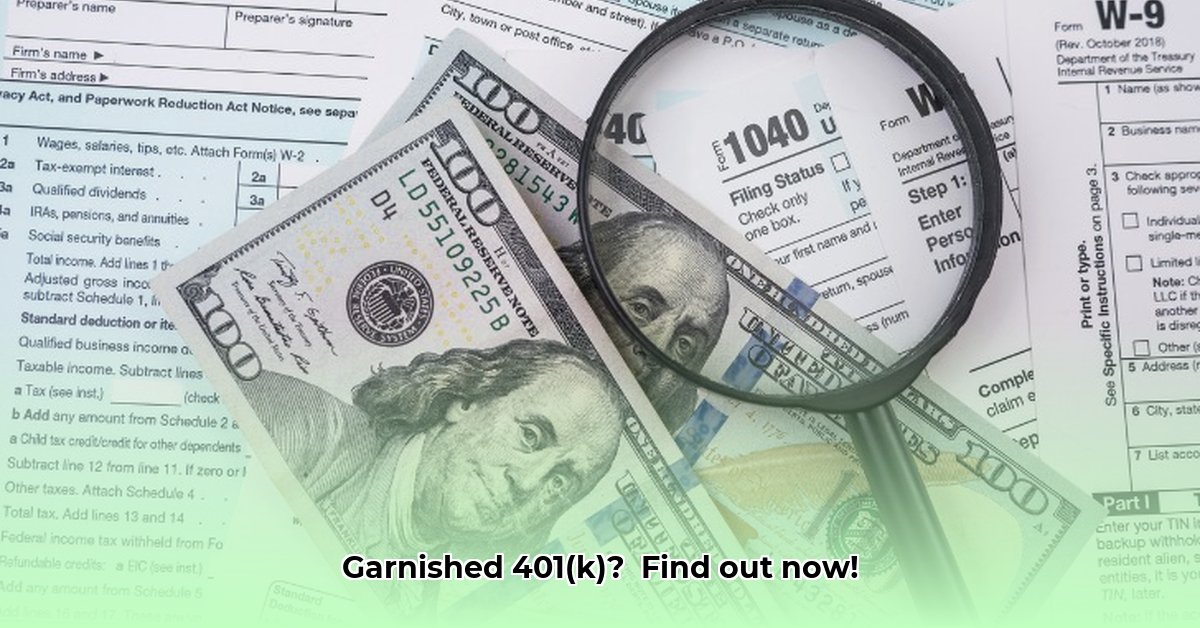
Worried about losing your retirement savings to creditors? Understanding the protections afforded to your 401(k) is crucial, especially after withdrawing funds. This guide clarifies the complexities of 401(k) protection and provides actionable steps to safeguard your retirement security. For further financial security advice, see information on foreclosure options.
If I Cash Out My 401(k), Can It Be Garnished?
Considering a 401(k) withdrawal? A key concern is whether creditors can access those funds. The answer hinges on several factors.
Your 401(k): Protected, But Not Invulnerable
Many 401(k) plans are governed by ERISA (Employee Retirement Income Security Act of 1974). ERISA generally shields your 401(k) from creditors, even in bankruptcy. However, this protection isn't absolute. Certain exceptions exist, particularly after distribution.
When Your 401(k) Might Be at Risk
Even with ERISA protection, specific circumstances can expose your 401(k) to garnishment, especially post-withdrawal:
IRS Levies: The IRS can seize 401(k) distributions to satisfy unpaid taxes. This power overrides ERISA protections. Your funds are generally protected within the 401(k) plan, but this protection ends once you withdraw them.
Child Support and Alimony: Court-ordered child support or alimony payments can often access your 401(k) funds, regardless of whether you've withdrawn them or not. State laws vary greatly, so understanding your specific state’s regulations is vital.
Solo 401(k)s: Solo 401(k)s and similar independent plans, not covered by ERISA, have different protection levels. These plans often offer less creditor protection, with state laws largely dictating the outcome.
Post-Withdrawal Vulnerability: The key takeaway: upon withdrawing funds, the ERISA shield disappears. The money becomes indistinguishable from other assets, losing its special protected status.
Protecting Your Retirement Nest Egg: A Proactive Approach
Knowing the risks is essential. Here's how to proactively protect your retirement savings:
Review Your Plan Documents: Meticulously review your 401(k) plan documents. Understanding your plan's specific rules and protections is the cornerstone of safeguarding your funds.
Understand ERISA's Limitations: Familiarize yourself with ERISA and its limitations. Don't hesitate to seek professional help if needed. A clear understanding of ERISA's scope and exceptions is crucial.
Consult Professionals: Before withdrawing funds, consult both a financial advisor and an attorney. They can assess your financial situation and provide tailored advice. This expert guidance is invaluable.
Maintain Sound Finances: Prudent financial management minimizes the likelihood of legal actions that could jeopardize your retirement savings. Address potential debt issues proactively.
Explore Alternatives: Before cashing out, explore alternatives such as loans. These alternatives might allow you to access funds without jeopardizing your retirement savings.
How to Protect a Solo 401(k) from Creditors
Key Takeaways:
- ERISA-covered 401(k)s provide strong creditor protection, but exceptions exist.
- Solo 401(k) protection varies significantly by state; consult with a legal professional.
- Tax liens and court-ordered payments generally supersede most protections.
- Proactive planning is paramount to minimizing risk.
Protecting your retirement savings is paramount. But how do you shield a Solo 401(k) from creditors? The answer's intricacy stems from the variability of state laws.
Traditional 401(k)s vs. Solo 401(k)s: A Crucial Distinction
Traditional, ERISA-governed 401(k)s generally enjoy robust protection from creditors. However, IRS levies for unpaid taxes and court-ordered payments (child support, alimony) can override this protection.
Solo 401(k)s lack the same federal protections. Your state's laws determine the level of protection, making it crucial to understand your state's specific regulations.
Navigating State-Specific Laws: Legal Counsel is Essential
The inconsistent nature of state laws necessitates meticulous research. Determine what level of protection, if any, your state offers for solo 401(k)s beyond basic bankruptcy rules. Seek legal counsel; this is not a DIY task.
Strategies for Protecting Your Solo 401(k)
Several strategies can help mitigate risk:
Professional Guidance: Engage both a financial advisor and an attorney specializing in asset protection and retirement planning. Tailored advice is critical.
Proactive Planning: Address creditor protection before facing financial hardship. Early consultation with legal counsel is highly recommended.
Asset Diversification: Diversify your assets to minimize the impact of potential losses. Consider adding other retirement or investment vehicles to your portfolio.
Acknowledge Limitations: Tax liens and court-ordered payments typically override most protections.
Facing Creditor Action: Legal Representation is Crucial
If creditors target your solo 401(k), you'll likely face legal action. The outcome depends on several factors. Legal representation is essential. You may need to defend your claim in court.
Securing Your Retirement Future
While the risk of losing your retirement savings is real, proactive planning and professional counsel can mitigate this threat. Understanding your specific state's regulations and seeking expert guidance is vital in protecting your hard-earned funds.